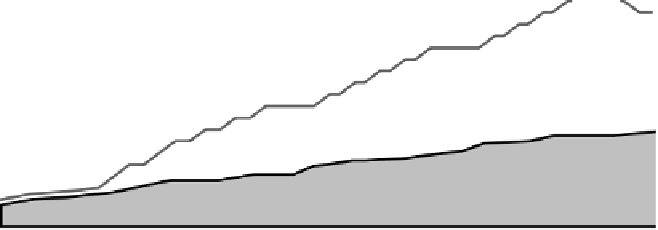Geoscience Reference
In-Depth Information
Wherever possible, the advancing faces of each lift should attempt to develop a
convex configuration to encourage three-dimensional restraint effects. In addition,
the advancing slope should constitute a buttress to provide the appropriate
containment and stability of waste rock. These buttresses must also be constructed
of high geotechnical quality waste rock, with low fines waste. Fines waste with high
water content or low-resistance must be encapsulated in cells located behind the
buttress. In order to manage the waste materials properly, sand and fines content of
the waste should be checked periodically [MOR 06].
Tau/Sigma Ratio: 0.33
1.483
4.0
3.9
3.8
S3
3.7
S1
3.6
S4
S3
3.5
S2
3.4
S1
S5
S4
3.3
S3
3.2
S2
S1
3.1
S4
3.0
2.9
2.8
2.7
0.0
0.2
0.4
0.6
0.8
1.0
1.2 1.4
1.6
1.8
2.0
2.2
2.4
2.6 2.8
3.0
3.2
3
Horizontal Distance (m) (x 1000)
Distancia Horizontal (m) (x 1000)
Figure 4.18.
Example of the stability analysis of a high waste rock dump by
limit equilibrium methods - static cases
[ARC 06-07]
4.7. Operation considerations
Designing a HWRD must take into account the many operational aspects that
require specific solutions.
4.7.1.
Basal drainage system
A drainage system is a critical part in the conception of a waste rock dump.
General practice, used in most mines, is to exploit the segregation into grain sizes
during dumping and to rely on the permeability of the coarser layers deposited at the
bottom of the dump lifts, formed mostly by large sized particle and blocks. This
practice has proven to be valid for many cases where “normal” conditions prevail.
There are also many situations where a drainage system of this type could fail,
however, in the sense that it will not allow free drainage of the dump. This could


































































Search WWH ::

Custom Search